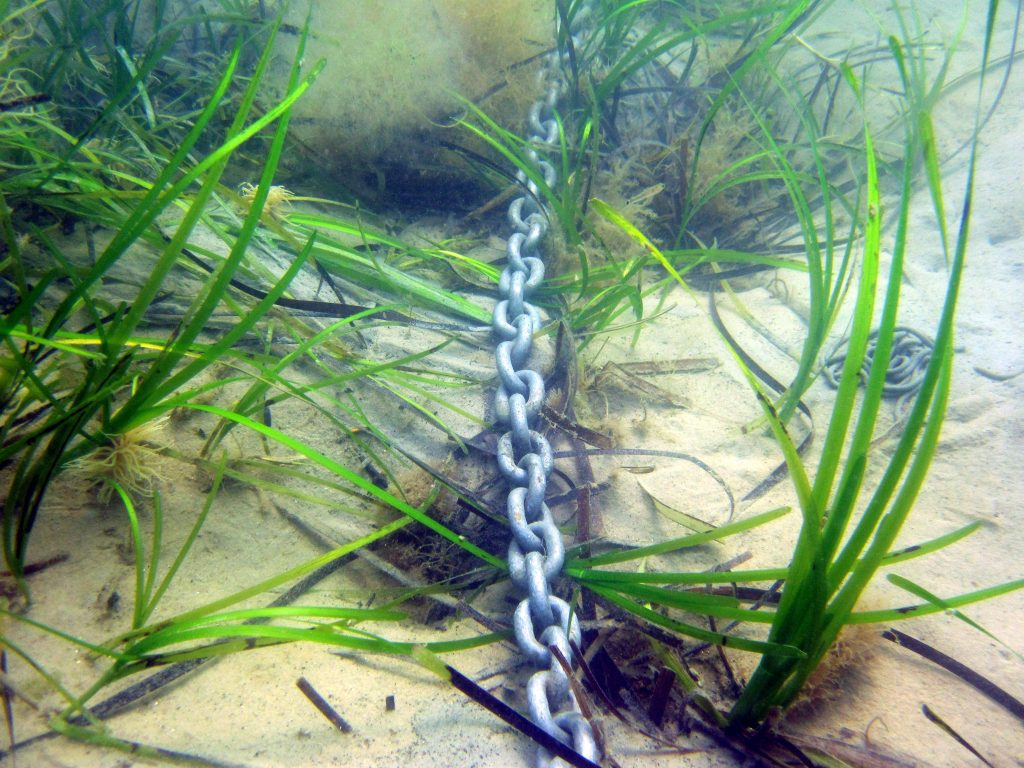
New Studland Bay eco-moorings to protect seagrass meadows and seahorses
The Studland Bay Marine Partnership has successfully raised the £66,000 needed to install 22 eco-moorings, sustainable alternatives to anchors that protect Studland’s seagrass meadows and seahorses.
Local marine and conservation groups have teamed up to raise £66,000 and continue an innovative project to protect Studland Bay’s seagrass and seahorse population. The Studland Bay Marine Partnership – comprising stakeholders from the boating community, conservation charities, researchers, grassroots organisations, local councils and statutory bodies – formed in December 2021 with the goal of developing solutions that support sustainable recreation.
The group has now raised £66,000 via a mixture of crowdfunding by The Seahorse Trust as well as generous donations from the National Trust, The Crown Estate and THE PIG-on the beach. The money will enable the installation of 22 eco-moorings, which will allow for further seabed restoration and protect seagrass meadows from harm. It is part of a phased approach with an overall target to install up to 87 across the bay area.
The fundraising effort follows an extensive engagement period with local residents and boat users to understand their views on awareness and usage of the eco-moorings and the Voluntary No Anchor Zone. Of those surveyed, 58% of respondents said they were interested in the conservation of the seagrass habitat.

“We are thrilled to have reached this milestone,” said Neil Garrick-Maidment, Founder and Executive Director of The Seahorse Trust. “These vital funds will enable further protection for the precious seahorse population at Studland Bay. With dwindling seahorse numbers across the UK, simple steps such as the installation of eco-moorings bring space and time for recovery and will help breathe new life at Studland. We hope this positive news story can show the public that every penny counts when it comes to grassroots fundraising and conservation efforts and these vital funds will help save this unique species’ home from destruction.”
What are eco-moorings?
Regular anchors cause damage to the seabed by uprooting seagrass. Eco-moorings offer an environmentally friendly alternative as a helical screw anchor is installed into the seabed. An elastic rode is then attached, connecting the anchor system with the mooring buoy. The elastic rode will stretch at higher tides and contract at lower tides, so the equipment does not damage the surrounding seagrass.
The partnership has successfully installed 10 eco-moorings to date. The purchase of these moorings is a hugely positive step for local conservation efforts at Studland Bay, as they will enable further seabed restoration and protect seagrass meadows from harm, whilst allowing recreation to continue.

The impact of innovative projects like this is already becoming clear – 2020 saw a huge return in seahorse sightings, with double figures spotted in multiple dives, including 16 spotted in a single dive with a peak of 21. The Seahorse Trust noted it was likely due to the unusually quiet period of moorings as a result of the Covid-19 pandemic. Studland Bay also became protected as a Marine Conservation Zone in 2019, and in December 2021 a Voluntary No Anchoring Zone was introduced.
What is so important about the seagrass at Studland Bay?
Studland Bay’s sheltered nature and its shallow, sandy seabed provides an ideal environment for the formation of dense seagrass meadows. Seagrasses are flowering plants that live in shallow sheltered areas along the coast. They have bright green leaves which form large, dense meadows under the sea.
Much like rainforests and coral reefs, these underwater gardens are full of life, hosting a wide variety of species. In fact, over 30 times more animals live within seagrass compared to adjacent sandy habitats. However, also like rainforests and coral reefs, they face severe threats: globally, it is estimated that we lose an area of seagrass around the same size as two football pitches every hour and we’ve lost over 35% of our seagrass meadows since 1980 – protecting what is left is vital.
Seagrass meadows provide essential shelter for a wide variety of fish, including pipefish, seahorses, wrasses, bass and bream, as well as crustaceans and molluscs. Studland Bay’s seagrasses are home to the protected spiny seahorse (Hippocampus guttulatus), while short snouted seahorse (Hippocampus hippocampus) are not resident but occasionally seen. Both species breed at the site – in fact, this is the only place in the UK where spiny seahorse produce young.

Seagrass roots also stabilise the seabed sediment, preventing erosion. And the habitat plays a vital role in carbon reduction, with the ability to store twice as much carbon per hectare as terrestrial forests. In fact, one hectare of seagrass can produce 100,000 litres of oxygen per day.
“We are hugely grateful to the organisations who have kindly donated the necessary funds to help springboard this vital project to the next phase,” said David Brown of the National Trust. “Studland is important to the million plus visitors it receives every year, by sea and land. However, the seagrass and marine life such as the spiny seahorse are an emblem of British marine life and it is important that nature-positive approaches such as eco-moorings are available, to enable recreation to continue whilst helping this precious habitat recover and thrive.”
The Seahorse Trust – a small, dedicated and world-leading charity for seahorses and the natural world – are fundraising to install further eco-moorings; you can support the campaign here.
Photos: Neil Garrick-Maidment, The Seahorse Trust








